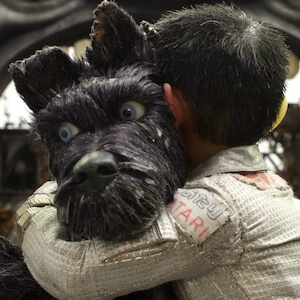“Whatever happened to man’s best friend?” a host of characters woefully opine in Part I of Isle of Dogs. Deprived of context, it’s a funny bit of dialogue, but within the confines of its script, no one would mistake it for comedy. And so it is with Wes Anderson’s latest oddball entry into the film world; Isle of Dogs — say it out loud a few times — loves its furry friends very much and isn’t shy to take that love very seriously.
At first glance, it might be hard to imagine a film that deftly walks these fine lines: bleak vs. warm; silly vs. serious; cat vs. dog. They all seem at starkly odds with each other, and yet they dance a delicate ballet, akin to Anderson’s best works.
And at the heart of it all? Dogs. Anderson has spent his career crafting dollhouse realities, only recently turning to bigger stories and more relatable arenas (childhood in Moonrise Kingdom, memory in Grand Budapest Hotel). Isle of Dogs feels like the culmination of that shift, finding Anderson at his most relatable… and sometimes his most confounding.
“Go Ahead, Say It… I’m a Stray”
It may not be altogether surprising, but the most developed characters at the heart of Isle of Dogs are, well, dogs. A targeted species in a (not-subtly) cat friendly Megasaki, dogs are infected with an outbreak of snout fever and dog flu, a disease threatening to break into the human sphere. The stern Mayor Kobayashi acts quickly, jettisoning all canines to Trash Island, starting with his ward’s bodyguard dog, Spots.
 The early narrative mainly focuses on a ragtag group of house pets, joined by a stray (Chief) who seems more at home than any of his companions. The group is well-voiced and adds an undeniably charismatic flavor to what could be considered a pretty dark movie. But the real heart at the center of the story is Chief’s relationship with Atari, the young boy who defies his distant uncle to set out on his own in search of Spots. While his comrades are all immediately loyal to the little pilot, Chief is defiant — “I bite,” he often threatens — an instinct bred by his years on the street and an untold backstory.
The early narrative mainly focuses on a ragtag group of house pets, joined by a stray (Chief) who seems more at home than any of his companions. The group is well-voiced and adds an undeniably charismatic flavor to what could be considered a pretty dark movie. But the real heart at the center of the story is Chief’s relationship with Atari, the young boy who defies his distant uncle to set out on his own in search of Spots. While his comrades are all immediately loyal to the little pilot, Chief is defiant — “I bite,” he often threatens — an instinct bred by his years on the street and an untold backstory.
Anderson has always been a compelling writer, but his growth is cemented in Chief’s character, his most sympathetic and vulnerable protagonist outside of Moonrise Kingdom’s Sam Shakusky. Chief’s commitment to grousing is slowly broken through Atari’s boyish presence and care, his story gently unfolding over the full length of the film. A lot of credit goes to Bryan Cranston, whose voice is equal parts threatening and worn, a performance that hits like a freight train as Chief slowly comes to question why he is how he is — and if it’s possible he could want something more than a life on Trash Island.
Isle of Dogs has earned a designation as Anderson’s most political movie in the short time it’s been public. And while it’s not the main focus of the story, it’s a distinction that’s easy to see. Today’s world is lacking in grace and care, especially for the outsider. The relationship between a boy and his dog remains one of the simplest, most affecting examples of a loving relationship not based on anything other than unrequited love. There are a few especially touching scenes revolving around Atari and the dogs in his life that hit at the heart of this conditionless love, but they’re best left unspoiled.
Malicious Appropriation vs. Misplaced Admiration
It’s impossible to talk about this film responsibly without addressing the problem of cultural appropriation… or maybe more appropriately here, “cultural tourism.” Many have balked at the way the film approaches Japanese culture and history, dismissing the director’s carefully curated Japanese references as a misguided tribute rather than a stirring love letter. Somewhat surprisingly, it’s not a consensus opinion, creating a healthy dialogue surrounding a movie that most people agree is otherwise very good. I would recommend reading these pieces if you’re not familiar with the whole conversation: Justin Chang’s LA Times review, K. Austin Collins’ take for The Ringer, and Emily Yoshida’s piece for Vulture.
I recognize my position as a white American discussing cultural appropriation is conflicted at best. Stories told from a white perspective are likely always going to be in my blind spots, and the best way I can address that is bringing new voices into my sphere of influence. That being said, it is hard to watch Isle of Dogs and not feel oddly… comfortable with the movie. For a film so heavily influenced by Japan, it still feels very American. And all the criticisms I’ve read are fair: Anderson doesn’t seem to be as interested in exploring Japanese culture as he does using it as a backdrop to Anderson’s story. Would the film be appreciably different if it were set in Latin America? Maybe, but probably only slightly. And that’s a problem for which the film never really has an answer.
 Still, I think there is a larger conversation that needs to be had — and is happening from what I can tell — about the difference between careless-to-malicious appropriation and misguided sentiment. Anyone familiar with Anderson’s career would likely describe him as meticulous, detailed, or any other antithetical stance to “careless.” Anderson’s work is so beloved because of his attention to detail. This makes Isle of Dogs’ cultural tourism more confusing, but also maybe more understandable. No, the best intentions don’t automatically fix wrong steps, but I do think they’re worth illuminating, especially for a film whose heart is so big and so visible.
Still, I think there is a larger conversation that needs to be had — and is happening from what I can tell — about the difference between careless-to-malicious appropriation and misguided sentiment. Anyone familiar with Anderson’s career would likely describe him as meticulous, detailed, or any other antithetical stance to “careless.” Anderson’s work is so beloved because of his attention to detail. This makes Isle of Dogs’ cultural tourism more confusing, but also maybe more understandable. No, the best intentions don’t automatically fix wrong steps, but I do think they’re worth illuminating, especially for a film whose heart is so big and so visible.
“I Turn My Back / On Mankind! / Frost on Windowpane”
During Isle of Dogs’ opening scene, a narrator delivers the above haiku from the myth of the boy warrior in the movie’s fictional universe. Practically, it only serves as world-building material, setting the stage for the widespread dog persecution of Megasaki.
But I haven’t been able to get the haiku out of my head after seeing the movie twice. The opening lines are delivered in a humorous, but pointed way, suggesting the hero of the story is forsaking his kin for the kinder, gentler nature of man’s best friend. It’s a theme that carries through, as even the well-meaning human characters are painted as aloof, weak actors in a play much bigger than themselves. No amount of activism or insistence on “facts” can save the day in Megasaki… sound familiar?
Instead, Anderson’s tight, delightful fable teaches us that hope is found in something more enduring and universal than righteous fury or political power. And in a fashion atypical to Anderson work, the substance rings out far louder than the style.
There are a litany of truths affirmed in Isle of Dogs: “Greater love has no one than this: that he lay down his life for his friends”; “Love the sojourner, therefore, for you were sojourners”; “Religion that is pure and undefiled is this: to visit orphans and widows in their affliction.”
But perhaps the greatest example of Isle of Dogs commendable heart is its admiration of that unconditional love we’re always searching for. “Neither death, nor life, neither angels, nor demons, nor any powers, nor height, nor depth, nor anything else in all creation,” could easily be replaced with countless dog-related stand-ins. But why go to the trouble? Isle of Dogs is about as effective, touching, and funny an allegory as you’ll find.
Yes, the film has its issues: a film so concerned with affirming the inherent value of all peoples seems surprisingly callous about the value of Japanese culture. But it’s also a testament that the winning sentiment can shine through even amongst the imperfections.





